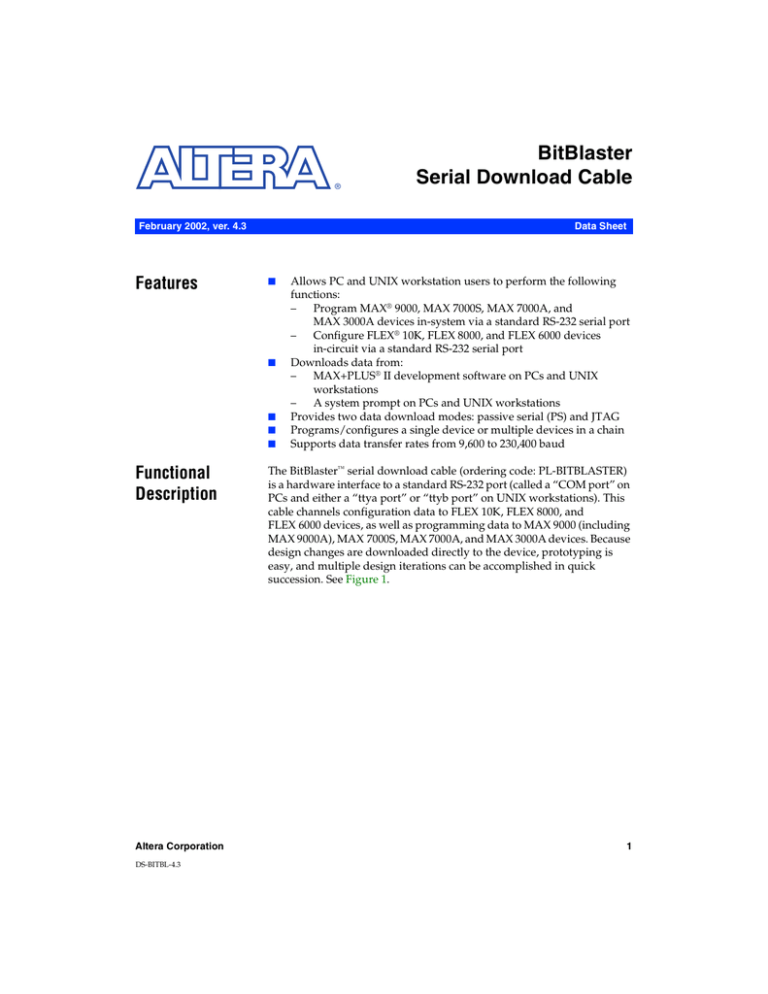
®
February 2002, ver. 4.3
Features
Data Sheet
■
■
■
■
■
Altera Corporation
DS-BITBL-4.3
Allows PC and UNIX workstation users to perform the following
functions:
–
Program MAX® 9000, MAX 7000S, MAX 7000A, and
MAX 3000A devices in-system via a standard RS-232 serial port
–
Configure FLEX® 10K, FLEX 8000, and FLEX 6000 devices
in-circuit via a standard RS-232 serial port
Downloads data from:
–
MAX+PLUS® II development software on PCs and UNIX
workstations
–
A system prompt on PCs and UNIX workstations
Provides two data download modes: passive serial (PS) and JTAG
Programs/configures a single device or multiple devices in a chain
Supports data transfer rates from 9,600 to 230,400 baud
The BitBlaster™ serial download cable (ordering code: PL-BITBLASTER)
is a hardware interface to a standard RS-232 port (called a “COM port” on
PCs and either a “ttya port” or “ttyb port” on UNIX workstations). This
cable channels configuration data to FLEX 10K, FLEX 8000, and
FLEX 6000 devices, as well as programming data to MAX 9000 (including
MAX 9000A), MAX 7000S, MAX 7000A, and MAX 3000A devices. Because
design changes are downloaded directly to the device, prototyping is
easy, and multiple design iterations can be accomplished in quick
succession. See Figure 1.
1
13
Development
Tools
Functional
Description
BitBlaster
Serial Download Cable
BitBlaster Serial Download Cable Data Sheet
Figure 1. BitBlaster Serial Download Cable
POW
ER
DON
E
BUS
Y
®
ERR
OR
BITBL
10-Pin
Female
Plug
ASTE
R
25-Pin
Female
RS-232
Port
Data Download Modes
The BitBlaster cable provides two data download modes:
■
■
Passive serial (PS) mode—Used for configuring FLEX 10K,
FLEX 8000, and FLEX 6000 devices
JTAG mode—Industry-standard JTAG boundary-scan test
(BST) circuitry (compliant with IEEE Std. 1149.1-1990)
implemented for programming or configuring FLEX 10K,
MAX 9000, MAX 7000S, MAX 7000A, and MAX 3000A devices.
BitBlaster Connections
Data is downloaded from the computer’s RS-232 port through the
BitBlaster cable to the circuit board via the connections described in
this section.
1
2
To configure/program 3.3-V devices (e.g., FLEX 10KA,
FLEX 10KB, FLEX 10KE, MAX 7000A, and MAX 3000A
devices) using the BitBlaster cable, connect the cable’s VCC
pin to a 5.0-V power supply and the device to a 3.3-V power
supply. 3.3-V Altera devices have 5.0-V tolerant inputs, so
the BitBlaster cable’s 5.0-V output will not harm these 3.0-V
devices. The pull-up resistors should be connected to the
5.0-V power supply.
Altera Corporation
BitBlaster Serial Download Cable Data Sheet
BitBlaster Female Port & Plug Connections
The 25-pin female port connects to an RS-232 port with a standard
serial cable. See Table 1.
Table 1. BitBlaster 25-Pin Serial Port Pin-Outs
Pin
Signal Name
Description
2
tx
Transmit data
3
rx
Receive data
4
rts
Request to send
5
cts
Clear to send
6
dsr
Data set ready
7
GND
Signal ground
20
dtr
Data terminal ready
The 10-pin female plug connects to a 10-pin male header on the
circuit board containing the target device(s). Figure 2 shows the
dimensions for the 10-pin female plug.
13
Development
Tools
Altera Corporation
3
BitBlaster Serial Download Cable Data Sheet
Figure 2. BitBlaster 10-Pin Female Plug Dimensions
Dimensions are shown in inches. The spacing between pin centers is 0.1 inch.
0.425 Typ.
Color Strip
1
3
5
7
9
2
4
6
8
10
0.250 Typ.
0.100 Sq.
0.025 Sq.
0.700 Typ.
Table 2 identifies the 10-pin female plug’s pin names for the
corresponding download mode.
Table 2. BitBlaster Female Plug’s Pin Names & Download Modes
Pin
JTAG Mode
Signal Name
4
Description
PS Mode
Signal Name
Description
1
TCK
Clock signal
DCLK
Clock signal
2
GND
Ground
GND
Ground
3
TDO
Data from
device
CONF_DONE
Configuration
done
4
VCC
Power supply
VCC
Power supply
5
TMS
JTAG state
machine control
nCONFIG
Configuration
control
6
NC
No connect
NC
No connect
7
NC
No connect
nSTATUS
Configuration
status
8
NC
No connect
NC
No connect
9
TDI
Data to device
DATA0
Data to device
10
GND
Ground
GND
Ground
Altera Corporation
BitBlaster Serial Download Cable Data Sheet
Circuit Board Header Connection
The BitBlaster 10-pin female plug connects to a 10-pin male header
on the circuit board. The 10-pin male header has two rows of five
pins connecting the circuit board to the device’s programming or
configuration pins. The BitBlaster cable receives power and
downloads data via the male header. Figure 3 shows the dimensions
of a typical 10-pin male header.
Figure 3. 10-Pin Male Header Dimensions
Dimensions are shown in inches.
Top View
Side View
0.100
0.100
0.025 Sq.
0.235
13
Development
Tools
1
The circuit board must supply VCC and ground to the
BitBlaster cable.
BitBlaster Status Lights
The BitBlaster status lights indicate the state of the device
configuration or programming. See Table 3.
Table 3. BitBlaster Status Lights
Status Light
Altera Corporation
Description
POWER
Indicates a connection to the target system’s power supply.
DONE
Indicates that device configuration or programming is complete.
BUSY
Indicates that device configuration or programming is in progress.
ERROR
Indicates error detection during configuration or programming.
5
BitBlaster Serial Download Cable Data Sheet
Data Transfer Rate
Control &
Operating
Conditions
Three dipswitches on the side panel of the BitBlaster cable control the
baud rate of the serial data. Table 4 shows the on/off dipswitch
settings, which can be used to specify transfer rates ranging from
9,600 to 230,400 baud. The configuration time for an EPF81188A
device, which uses 193,000 bits of configuration data, is also
provided for reference.
Table 4. Dipswitch Settings Note (1)
Baud Rate (BPS)
Dipswitch
Positions
230,400
EPF81188A
Configuration Time
(Seconds)
1.5
1
2
3
115,200
3.0
1
2
3
76,800
4.5
1
2
3
57,600
5.5
1
2
3
38,400
8.5
1
2
3
19,200
17.0
1
2
3
14,400
22.0
1
2
3
9,600
33.0
1
2
3
Note:
(1)
f
6
The supported baud rates vary depending on the computer system. Refer to
the computer system’s serial port hardware documentation to verify the
available baud rates.
Search for “Hardware Setup command” in MAX+PLUS II Help for
more information.
Altera Corporation
BitBlaster Serial Download Cable Data Sheet
Operating
Conditions
The Tables 5 through 7 summarize the absolute maximum ratings,
recommended operating conditions, and DC operating conditions
for the BitBlaster cable.
Table 5. BitBlaster Cable Absolute Maximum Ratings
Symbol
Parameter
Conditions
Min
Max
Unit
VCC
Supply voltage
With respect to ground
–2.0
7.0
V
VI
DC input voltage
With respect to ground
–2.0
7.0
V
Min
Max
Unit
4.75
5.25
V
Table 6. BitBlaster Cable Recommended Operating Conditions
Symbol
VCC
Parameter
Conditions
Supply voltage
5.0-V operation
13
Table 7. BitBlaster Cable DC Operating Conditions
Parameter
Conditions
Min
Max
Unit
V
VIH
High-level input voltage
2.0
VCC + 0.3
VIL
Low-level input voltage
–0.3
0.8
VOH
5.0-V high-level TTL output
voltage
IOH = –4 mA, VCC = 4.75 V
VOL
Low-level output voltage
IO L = 4 mA DC
ICC
Operating current
Altera Corporation
2.4
Development
Tools
Symbol
V
V
0.45
V
100
mA
7
BitBlaster Serial Download Cable Data Sheet
Figure 4 shows the typical 5.0-V output drive characteristics of the
BitBlaster cable.
Figure 4. BitBlaster Output Drive Characteristics
IO
Output Current (mA) Typ.
150
IOL
120
VCC = 5.0 V
Room Temperature
90
60
IOH
45
30
0.45
1
2
3
4
5
VO Output Voltage (V)
Software
Instructions
The MAX+PLUS II Programmer downloads configuration or
programming data. For FLEX 10K, FLEX 8000, and FLEX 6000
devices, configuration data can also be downloaded by copying the
SBF to the RS-232 port from the system prompt.
Downloading Configuration or Programming Data from the
MAX+PLUS II Programmer
To configure or program one or more devices with the BitBlaster
cable and the MAX+PLUS II Programmer, follow these steps:
8
1.
Compile a project. The MAX+PLUS II Compiler automatically
generates an SOF for FLEX 10K, FLEX 8000, and FLEX 6000
device configuration, or a POF for MAX 9000, MAX 7000S,
MAX 7000A, or MAX 3000A device programming.
2.
Attach the BitBlaster cable to an RS-232 port on a PC or UNIX
workstation and plug the 10-pin female header into the system
containing the target device. Ensure that the POWER status
light is on. The board must supply power to the BitBlaster
cable.
Altera Corporation
BitBlaster Serial Download Cable Data Sheet
3.
If necessary, change the BitBlaster cable’s baud rate using the
dipswitches on its side panel. Dipswitch settings are listed in
Table 4 on page 6.
4.
Open the MAX+PLUS II Programmer. Choose the Hardware
Setup command (Options menu) to specify the BitBlaster cable
and the appropriate RS-232 port. See “Changing the Hardware
Setup” in MAX+PLUS II Help for more information.
1
5.
When you first open the Programmer, the MAX+PLUS II
software automatically loads the programming file for the
current project (either a POF or SOF), or the first
programming file for a multi-device project. To specify
another programming file, choose Select Programming
File (File menu) and specify the correct file type. For a
FLEX 10K, FLEX 8000, or FLEX 6000 device, select an SOF;
for a MAX 9000, MAX 7000S, MAX 7000A, or MAX 3000A
device, select a POF.
For JTAG or FLEX-chain programming or configuration,
perform the following:
13
1
If the JTAG chain includes either FLEX or MAX devices
exclusively, set up and create just one JTAG Chain File
(.jcf). If the JTAG chain includes a mixture of FLEX and
MAX devices, set up and create two separate JCFs.
v To configure multiple devices in a FLEX chain, turn on
Multi-Device FLEX Chain (FLEX menu) and choose
Multi-Device FLEX Chain Setup to setup the multi-device
FLEX chain. See “Setting Up Multi-Device FLEX Chains”
in MAX+PLUS II Help for more information.
6.
Altera Corporation
Choose the Program or Configure button to program or
configure the device(s). The BUSY status light on the BitBlaster
cable turns on.
9
Development
Tools
v To program or configure devices in a JTAG chain (multi- or
single-device chain), turn on Multi-Device JTAG-Chain
(JTAG menu) and choose Multi-Device JTAG Chain
Setup to set up the multi-device JTAG chain. See “Setting
up Multi-Device JTAG Chains” in MAX+PLUS II Help for
more information.
BitBlaster Serial Download Cable Data Sheet
The BitBlaster cable downloads the data from the SOFs or POFs into
the device(s). When configuration or programming is complete, the
BUSY status light turns off, and the DONE status light turns on. After
the DONE status light turns on, the BitBlaster can be disconnected.
Downloading Configuration Data from a System Prompt
(FLEX Devices Only)
To configure one or more FLEX 10K, FLEX 8000, or FLEX 6000
devices with the BitBlaster cable from a system prompt, follow these
steps:
1.
Compile the project(s) with the MAX+PLUS II Compiler. The
Compiler automatically generates an SOF for device
configuration.
2.
Open the MAX+PLUS II Programmer or Compiler and choose
the Convert SRAM Object Files command (File menu).
3.
Specify the SOF name by selecting it in the Files box or by
typing its name in the File Name box. Choose Add to add the file
to the Selected Files box.
4.
Specify the serial bitstream file format by selecting .sbf
(Sequential) in the File Format drop-down list box. Choose OK.
5.
Attach the BitBlaster cable to an RS-232 port on your PC or
UNIX workstation, and plug the 10-pin female header into the
prototype system that contains the target FLEX 10K, FLEX 8000,
or FLEX 6000 device(s). Ensure that the POWER status light is
on. The board must supply power to the BitBlaster cable.
6.
If necessary, change the baud rate of the BitBlaster cable using
the dipswitches on its side panel. Dipswitch settings are listed
in Table 4 on page 6.
7.
Specify the baud rate of the target RS-232 (serial) port.
v On a PC, type the following command at the system
prompt:
mode com <serial port number>:<baud rate>,N,8,1
10
Altera Corporation
BitBlaster Serial Download Cable Data Sheet
1
Older versions of DOS may not support rates
greater than 9,600 baud. Altera provides a
slikmode.exe utility that sets higher rates for
these older operating systems. The
slikmode.exe utility is available from the
/pub/misc directory of the Altera FTP site
(ftp.altera.com) as a self-extracting
executable, bitmode.exe. To use the
slikmode.exe utility, type the following
command at the system prompt:
slikmode/b<baud rate>/c<serial port
number>
For instructions on using the slikmode.exe
utility, type slikmode at the system prompt.
stty <baud rate> /dev/<serial port id>
Check the workstation specifications to determine the
maximum baud rate allowed by the hardware.
8.
Configure the FLEX 10K, FLEX 8000, or FLEX 6000 device by
copying the SBF to the serial port to which the BitBlaster cable
is attached.
v On a PC, type the following command from the system
prompt:
copy <filename>.sbf com<serial port number>:
v Because commands on UNIX workstations differ
depending on the operating system, the following
command is provided only as an example. On a UNIX
workstation, type the following command from the system
prompt:
cp <filename>.sbf /dev/<serial port id>
Altera Corporation
11
13
Development
Tools
v Because commands on UNIX workstations differ
depending on the operating system, the following
command is provided only as an example. On a UNIX
workstation, type the following command from the system
prompt:
BitBlaster Serial Download Cable Data Sheet
Conclusion
Downloading configuration and programming data directly to the
device via the BitBlaster cable allows designers to verify multiple
design iterations in quick succession, thereby speeding the design
cycle.
References
For more information on configuration and in-system
programmablility (ISP), see the following sources:
■
■
■
■
■
■
Revision History
Application Note 116 (Configuring APEX 20K, FLEX 10K & FLEX
6000 Devices)
Application Note 33 (Configuring FLEX 8000 Devices)
Application Note 38 (Configuring Multiple FLEX 8000 Devices)
Application Note 39 (IEEE 1149.1 (JTAG) Boundary-Scan Testing in
Altera Devices)
Application Note 95 (In-System Programmability in MAX Devices)
Search for “Configuring a Single Device with the BitBlaster,
ByteBlaster, or FLEX Download Cable,” “Setting Up MultiDevice JTAG Chains,” ”Configuring Multiple Devices in a JTAG
Chain with the BitBlaster or ByteBlaster,” and “Programming a
Single Device with BitBlaster or ByteBlaster” in MAX+PLUS II
Help.
The information contained in the BitBlaster Serial Download Cable
Data Sheet version 4.3 supersedes information published in previous
versions.
Version 4.3 Changes
The BitBlaster Serial Download Cable Data Sheet version 4.3 contains
the following changes: updated procedures in “Downloading
Configuration Data from a System Prompt (FLEX Devices Only)” on
page 10.
12
Altera Corporation
BitBlaster Serial Download Cable Data Sheet
Version 4.02 Changes
The BitBlaster Serial Download Cable Data Sheet version 4.02 contains
the following changes:
■
■
■
■
■
Information on MAX 3000A devices was added throughout the
document.
The “Passive Serial Mode” section was removed. This
information is found in Application Note 116 (Configuring
APEX 20K, FLEX 10K & FLEX 6000 Devices).
The “JTAG Mode” section was removed. This information is
found in Application Note 39 (IEEE 1149.1 (JTAG) Boundary-Scan
Testing in Altera Devices) and Application Note 95 (In-System
Programmability in MAX Devices).
The “References” section was added, which provides sources
for additional information on the BitBlaster download cable.
Minor textual, illustration, and style changes were made to the
data sheet.
13
Version 4.01 Changes
■
■
■
Altera Corporation
References to MAX 9000A devices were added as needed.
References to FLEX 10KB and FLEX 10KE devices were added to
the configuring/programming 3.3-V devices paragraph in the
“BitBlaster Connections” section.
Minor textual, illustration, and style changes were made to the
data sheet.
13
Development
Tools
The BitBlaster Serial Download Cable Data Sheet version 4.01 contains
the following changes:
BitBlaster Serial Download Cable Data Sheet
101 Innovation Drive
San Jose, CA 95134
(408) 544-7000
http://www.altera.com
Applications Hotline:
(800) 800-EPLD
Literature Services:
lit_req@altera.com
14
Copyright © 2002 Altera Corporation. All rights reserved. Altera, The Programmable Solutions Company, the
stylized Altera logo, specific device designations, and all other words and logos that are identified as
trademarks and/or service marks are, unless noted otherwise, the trademarks and service marks of Altera
Corporation in the U.S. and other countries. All other product or service names are the property of their
respective holders. Altera products are protected under numerous U.S. and foreign patents and pending
applications, mask work rights, and copyrights. Altera warrants performance of its semiconductor products
to current specifications in accordance with Altera's standard warranty, but reserves the
right to make changes to any products and services at any time without notice. Altera
assumes no responsibility or liability arising out of the application or use of any
information, product, or service described herein except as expressly agreed to in writing
by Altera Corporation. Altera customers are advised to obtain the latest version of device
specifications before relying on any published information and before placing orders for
products or services
Altera Corporation


